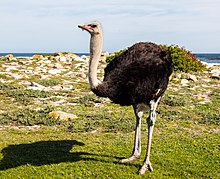
Back نعامية Arabic Waikoy (Struthionidae) AVK Dəvəquşular Azerbaijani Struthionidae Breton Estruciònids Catalan Pštrosovití Czech Strudse Danish Strauße (Gattung) German Struthionidae Spanish شترمرغان Persian
| Struthionidae | |
|---|---|

| |
| Struthio camelus australis at the Cape of Good Hope, South Africa | |
| Scientific classification | |
| Domain: | Eukaryota |
| Kingdom: | Animalia |
| Phylum: | Chordata |
| Class: | Aves |
| Infraclass: | Palaeognathae |
| Order: | Struthioniformes Latham, 1790 |
| Family: | Struthionidae Vigors, 1825[1] |
| Type genus | |
| Struthio Linnaeus, 1758
| |
| Genera | |
| Synonyms[2] | |
| |
Struthionidae (/ˌstruːθiˈɒnədiː/; from Latin strūthiō 'ostrich', and Ancient Greek εἶδος (eîdos) 'appearance, resemblance') is a family of flightless birds, containing the extant ostriches and their extinct relatives. The two extant species of ostrich are the common ostrich and Somali ostrich, both in the genus Struthio, which also contains several species known from Holocene fossils such as the Asian ostrich. The common ostrich is the more widespread of the two living species, and is the largest living bird species. The extinct genus Pachystruthio from the Late Pliocene-Early Pleistocene of Eurasia is one of the largest birds ever.[3]
The first species of Struthio appear during the Miocene epoch, though various Paleocene, Eocene, and Oligocene fossils may also belong to the family.[4][5] Ostriches are classified in the ratite group of birds, all extant species of which are flightless, including the kiwis, emus, and rheas. Traditionally, the order Struthioniformes contained all the ratites. However, recent genetic analysis has found that the group is not monophyletic, as it is paraphyletic with respect to the tinamous, so the ostriches are usually classified as the only members of the order,[6][7] though the IUCN uses a broader classification and includes all "ratites" and tinamous in Struthioniformes.[8]
- ^ Vigors, Nicholas Aylward (1825). "Observations on the natural affinities that connect the orders and families of birds". Transactions of the Linnean Society of London. 14 (3): 395-517 [483].
- ^ Mlíkovský, Jiří (2002). Cenozoic birds of the world Part 1 : Europe (PDF). Praha: Ninox Press. p. 60. ISBN 80-901105-3-8.
{{cite book}}: CS1 maint: ignored ISBN errors (link) - ^ Zelenkov, N. V.; Lavrov, A. V.; Startsev, D. B.; Vislobokova, I. A.; Lopatin, A. V. (2019). "A giant early Pleistocene bird from eastern Europe: unexpected component of terrestrial faunas at the time of early Homo arrival". Journal of Vertebrate Paleontology. 39 (2): e1605521. Bibcode:2019JVPal..39E5521Z. doi:10.1080/02724634.2019.1605521. S2CID 198384367.
- ^ Buffetaut, E.; Angst, D. (November 2014). "Stratigraphic distribution of large flightless birds in the Palaeogene of Europe and its palaeobiological and palaeogeographical implications". Earth-Science Reviews. 138: 394–408. doi:10.1016/j.earscirev.2014.07.001.
- ^ Agnolin et al, Unexpected diversity of ratites (Aves, Palaeognathae) in the early Cenozoic of South America: palaeobiogeographical implications Article in Alcheringa An Australasian Journal of Palaeontology · July 2016 DOI: 10.1080/03115518.2016.1184898
- ^ Hackett, S.J. et al. (2008) A Phylogenomic Study of Birds Reveals Their Evolutionary History. Science, 320, 1763.
- ^ Yuri, T. (2013) Parsimony and model-based analyses of indels in avian nuclear genes reveal congruent and incongruent phylogenetic signals. Biology, 2:419–44.
- ^ "The IUCN Red List of Threatened Species". IUCN Red List of Threatened Species. Retrieved 2020-04-10.